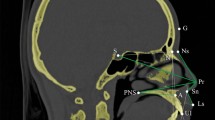Abstract
Most Chinese have unpleasant facial profile of midfacial depression, which could be caused by multiple reasons. In the past, LeFort osteotomy and orthodontic methods were applied for surgical treatment of midfacial concavity. As the development of plastic surgery filling techniques, nasal base filling or concurrent comprehensive rhinoplasty has been widely used to improve midfacial depression. However, most of the related studies focus on surgical techniques or filling materials, yet lack accurate and objective aesthetic evaluation. In the current study, we used 3D imaging to collect 3D facial profile of 66 patients suffering from midfacial depression. Related linear distance and angles were measured accurately using 3D software. Patient satisfaction and physician evaluation were also collected in the follow-up period. The results showed that patients' midfacial depression were significantly improved after the surgery and the overall patient satisfaction was 100%. Our study demonstrated the positive role of nasal base filling in improving the midfacial depression, and illustrated the advantages of 3D imaging technology in personalized preoperative communication, surgical simulation and postoperative effect evaluation.
Level of evidence IV This journal requires that authors assign a level of evidence to each article. For a full description of these Evidence-Based Medicine ratings, please refer to the Table of Contents or the online Instructions to Authors www.springer.com/00266.




Similar content being viewed by others
References
Guan Mo PX (2019) Research progress in facial morphological features and aesthetic standards. Chin J Aesthetic Med 28(03):163–166
Louis M, Agrawal N, Kaufman M, Truong TA (2017) Midface Fractures I. Semin Plast Surg 31(2):85–93. https://doi.org/10.1055/s-0037-1601372
Jain U, Thakur G, Kallury A (2011) Binder’s syndrome. BMJ Case Rep. https://doi.org/10.1136/bcr.08.2011.4665
Sullivan SM (2016) Le Fort I Osteotomy. Atlas Oral Maxillofac Surg Clin North Am 24(1):1–13. https://doi.org/10.1016/j.cxom.2015.10.001
Malagon-Hidalgo HO, Vilchis-Lopez R, Gonzalez-Chapa DR, Silva-Suarez RA, Garcia-Cano E, Lastiri-Barrios JL, Gonzalez-Magana F (2018) Le Fort II Osteotomy and Modified Technique Presentation. J Craniofac Surg 29(6):1406–1411. https://doi.org/10.1097/SCS.0000000000004760
Shirvani A, Sadeghian S, Abbasi S (2016) Prediction of lip response to orthodontic treatment using a multivariable regression model. Dent Res J (Isfahan) 13(1):38–45. https://doi.org/10.4103/1735-3327.174697
Holmes AD, Lee SJ, Greensmith A, Heggie A, Meara JG (2010) Nasal reconstruction for maxillonasal dysplasia. J Craniofac Surg 21(2):543–551. https://doi.org/10.1097/SCS.0b013e3181d024b0
Fedok FG (2016) Primary Rhinoplasty. Facial Plast Surg Clin North Am 24(3):323–335. https://doi.org/10.1016/j.fsc.2016.03.009
Jeon YT, Han SJ (2019) Comparative study of the effect of paranasal augmentation with autologous bone in orthognathic surgery. J Oral Maxillofac Surg 77(10):2116–2124. https://doi.org/10.1016/j.joms.2019.04.028
Lee TS, Park S (2017) Use of pedicled buccal fat pad for midface augmentation. J Craniofac Surg 28(8):2133–2134. https://doi.org/10.1097/SCS.0000000000003931
Markiewicz MR, Bell RB (2011) The use of 3D imaging tools in facial plastic surgery. Facial Plast Surg Clin North Am, 19(4): 655-82, ix. doi:https://doi.org/10.1016/j.fsc.2011.07.009.
Yu MS, Jang YJ (2014) Preoperative computer simulation for Asian rhinoplasty patients: analysis of accuracy and patient preference. Aesthet Surg J 34(8):1162–1171. https://doi.org/10.1177/1090820X14547947
Klassen AF, Cano SJ, Schwitzer JA, Scott AM, Pusic AL (2015) FACE-Q scales for health-related quality of life, early life impact, satisfaction with outcomes, and decision to have treatment: development and validation. Plast Reconstr Surg 135(2):375–386. https://doi.org/10.1097/PRS.0000000000000895
Raschke R, Hazani R, Yaremchuk MJ (2013) Identifying a safe zone for midface augmentation using anatomic landmarks for the infraorbital foramen. Aesthet Surg J 33(1):13–18. https://doi.org/10.1177/1090820X12468752
Kim YI, Park SB, Son WS, Hwang DS (2011) Midfacial soft-tissue changes after advancement of maxilla with Le Fort I osteotomy and mandibular setback surgery: comparison of conventional and high Le Fort I osteotomies by superimposition of cone-beam computed tomography volumes. J Oral Maxillofac Surg 69(6):e225–e233. https://doi.org/10.1016/j.joms.2010.12.035
Bornstein MM, Yeung AWK, Tanaka R, von Arx T, Jacobs R, Khong PL (2018) Evaluation of health or pathology of bilateral maxillary sinuses in patients referred for cone beam computed tomography using a low-dose protocol. Int J Periodontics Restorative Dent 38(5):699–710. https://doi.org/10.11607/prd.3435
Yen CI, Chen RF, Zelken J, Chang CS, Yang SY, Chen HC, Chang SY, Yang JY, Chuang SS, Hsiao YC (2018) The influence of paranasal augmentation on the measurement of the nose for the treatment of midfacial concavity. Aesthet Surg J 38(3):241–251. https://doi.org/10.1093/asj/sjx166
Jayaratne YS, Deutsch CK, Zwahlen RA (2014) Stereophotogrammetry-based facial depth measurements: a novel method for quantifying facial projection. Surg Innov 21(1):59–64. https://doi.org/10.1177/1553350613475883
Ghoddousi H, Edler R, Haers P, Wertheim D, Greenhill D (2007) Comparison of three methods of facial measurement. Int J Oral Maxillofac Surg 36(3):250–258. https://doi.org/10.1016/j.ijom.2006.10.001
Artopoulos A, Buytaert JA, Dirckx JJ, Coward TJ (2014) Comparison of the accuracy of digital stereophotogrammetry and projection moire profilometry for three-dimensional imaging of the face. Int J Oral Maxillofac Surg 43(5):654–662. https://doi.org/10.1016/j.ijom.2013.10.005
Fink M, Hirschfelder U, Hirschinger V, Schmid M, Spitzl C, Detterbeck A, Hofmann E (2017) Assessment of facial soft-tissue profiles based on lateral photographs versus three-dimensional face scans. J Orofac Orthop 78(1):70–76. https://doi.org/10.1007/s00056-016-0055-z
Acknowledgements
The authors declare that they have no conflicts of interest.
Funding
This work has no grant supported.
Author information
Authors and Affiliations
Contributions
Jianfang Zhao (First author): concept, design, literature search, clinical studies, data analysis, manuscript writing, manuscript editing. Guanhuier Wang (First author): study design, clinical studies, data acquisition. Yang An: manuscript review. Dong Li (Corresponding author): definition of intellectual content, manuscript review. Zhao Jianfang and Wang Guanhuier contributed equally and were first co-authors of this article.
Corresponding author
Ethics declarations
Conflict of interest
All procedures performed in studies involving human participants were in accordance with the ethical standards of the institutional and national research committee and with the 1964 Helsinki Declaration and its later amendments or comparable ethical standards.
Ethical Approval
This manuscript has been read and approved by all the authors. The requirements for authorship have been met, and each author believes that the manuscript represents honest work.
Additional information
Publisher's Note
Springer Nature remains neutral with regard to jurisdictional claims in published maps and institutional affiliations.
Supplementary Information
Below is the link to the electronic supplementary material.
Rights and permissions
About this article
Cite this article
Jianfang, Z., Guanhuier, W., Yang, A. et al. Application of 3D Imaging-Assisted Precise Aesthetic Evaluation in Midfacial Depression Treatment. Aesth Plast Surg 46, 2799–2806 (2022). https://doi.org/10.1007/s00266-022-02867-x
Received:
Accepted:
Published:
Issue Date:
DOI: https://doi.org/10.1007/s00266-022-02867-x




